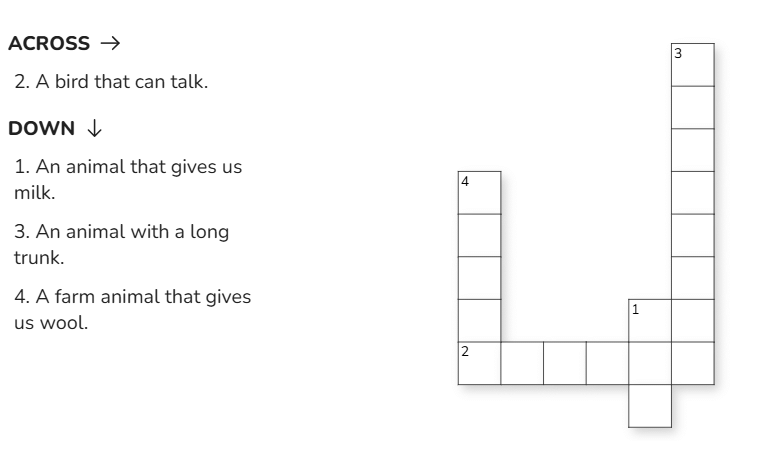Animals Around Us - CBSE Worksheets- 1
| Table of contents |

|
| Q1: Fill in the Blanks |

|
| Q2: Match the following |

|
| Q3: Name the following |

|
| Q4: Crossword Puzzle |

|
| Q5: TRUE or FALSE |

|
| Q6: Answer the following questions |

|

Q1: Fill in the Blanks
(Pick the correct word from the options in brackets)(i) Animals that animals can be kept at home are called _____ animals(domestic/wild)
(ii) _____ animals live in forests. (Wild/Domestic)
(iii) Hens give us _____. (eggs/wool)
(iv) Insects have _____ legs. (six/four)
(v) Cows give us _____. (milk/wool)
(vi) Birds have _____ to fly. (feet/wings)
Q2: Match the following

Q3: Name the following
(i) Two wild animals.
(ii) Two birds.
(iii) Two domestic animals.
(iv) Two pet animals.
Q4: Crossword Puzzle
(Fill in the boxes using the clues given below to complete the crossword.)

Q5: TRUE or FALSE
(Write TRUE or FALSE for the given statements)
(i) A mosquito has six legs.
(ii) A dog lives in water.
(iii) A parrot is a pet animal.
Q6: Answer the following questions
(i) What is a wild animal?
(ii) What are domestic animals?
(iii) Where will you find tigers and lions?
(iv) Do all animals eat only plants?
(v) Name two birds that cannot fly.
The solutions of the worksheet "Animals Around Us - 1"
|
33 videos|215 docs|44 tests
|
FAQs on Animals Around Us - CBSE Worksheets- 1
| 1. What are some common animals found in urban areas? |  |
| 2. How do animals adapt to living in different environments? |  |
| 3. Why are some animals more commonly seen than others in our surroundings? |  |
| 4. What role do urban animals play in the ecosystem? |  |
| 5. How can we coexist peacefully with urban wildlife? |  |















